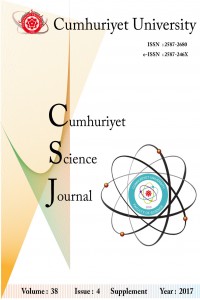Abstract
In machining operations, especially turning operations, there are many
factors that determine process efficiency and product quality. Factors such as
cutting forces, cutting zone temperatures, tool wear, chip morphology are the
basic elements that monitored in the development of machining applications. One
of the problems encountered during machining of materials commonly used by the
aerospace industry, such as Super Alloy, Titanium, Aluminum, is long and
continuous chip formation. A new methodology has been proposed in this study.
In this methodology, low frequency vibrations are used for chip breaking. In
this study, it is explained that it is possible to break the chip by using the
Computer Numerical Control (CNC) program within certain limits without using an
external device or chip breaker form insert.
References
- [1]. Stephenson D.A., Agapiou J.S., Metal cutting theory and practice, 2nd ed. Boca Raton, FL: CRC Taylor & Francis, 2006.
- [2]. Smith G.T. Cutting tool technology: industrial handbook. London: Springer, 2008.
- [3]. Berglind L. ve Ziegert J., “Modulated Tool Path (MTP) Machining for Threading Applications”, Procedia Manuf., c. 1, ss. 546–555, 2015.
- [4]. Balevicius G., Ostaševičius V., Jurėnas V., Baskutienė J., Zakrasas R. “Investigation of vibration assisted drilling prospects for improving machining characteristics of hard to machine materials at high and low frequency ranges”, Mechanics, c. 22, sayı 2, Nis. 2016.
- [5]. Chhabra P.N., Ackroyd B., Compton W.D., Chandrasekar S. “Low-frequency modulation-assisted drilling using linear drives”, Proc. Inst. Mech. Eng. Part B J. Eng. Manuf., c. 216, sayı 3, ss. 321–330, Mar. 2002.
- [6]. Debnath K., Singh I. “Low-frequency modulation-assisted drilling of carbon-epoxy composite laminates”, J. Manuf. Process., c. 25, ss. 262-273, Oca. 2017.
- [7]. Joshi R.S., Singh H. “Characteristic studies of brass particulates fabricated by modulation assisted machining”, Int. J. Adv. Manuf. Technol., c. 73, sayı 9-12, ss. 1533-1542, Ağu. 2014.
- [8]. Berglind L., Ziegert J. “Chip Breaking Parameter Selection for Constant Surface Speed Machining”, 2013, s. V02BT02A039.
- [9]. DiMarco C., Ziegert J.C., Vermillion C. “Exponential and sigmoid-interpolated machining trajectories”, J. Manuf. Syst., c. 37, ss. 535-541, Eki. 2015.
- [10]. Mann J.B., Guo Y., Saldana C., Compton W. D., Chandrasekar S. “Enhancing material removal processes using modulation-assisted machining”, Tribol. Int., c. 44, sayı 10, ss. 1225-1235, Eyl. 2011.
- [11]. Mann J.B., Chandrasekar S., Compton W.D. “Tool holder assembly and method for modulation-assisted machining”, US7587965 B2.
- [12]. Miyake A., vd., “Effect of low frequency vibration applied to feed direction on turning process”, 2016, ss. 356-358.
- [13]. Pecat O. ve Meyer I., “Low Frequency Vibration Assisted Drilling of Aluminium Alloys”, Adv. Mater. Res., c. 769, ss. 131–138, Eyl. 2013.
- [14]. Sugihara T., Enomoto T. “Ultra-Low-Frequency Vibration Assisted Machining of Ti-6Al-4V Alloy”, Int. J. Autom. Technol., c. 10, sayı 4, ss. 647-653, Tem. 2016.
Değişken İlerleme Hızları Kullanılarak Tornalama İşleminde Talaş Kırma Uygulaması ile İlgili Yeni Bir Yaklaşım
Abstract
Talaşlı imalat işlemlerinde, özellikle tornalama
operasyonunda, işlem verimini ve ürün kalitesini belirleyen pek çok unsur
mevcuttur. Kesme kuvvetleri, kesme bölgesi sıcaklığı, takım aşınması, üretilen
talaş profili gibi unsurlar talaşlı imalat uygulamalarının geliştirilmesinde
izlenen temel unsurlardır. Süper alaşım, Titanyum, Alüminyum gibi özellikle
havacılık ve uzay sektörü tarafından yaygın olarak kullanılan malzemelerin
talaşlı imalatı sırasında karşılaşılan problemlerden birisi de uzun ve sürekli
talaş oluşumudur. Bu çalışmada yeni bir metodoloji önerilmiştir. Bu
metodolojide talaş kırma işlemi için düşük frekansta titreşimler
kullanılmıştır. Bu çalışmada harici bir eleman veya talaş kırıcı formlu insert
kullanmaksızın belirli limitler dâhilinde bilgisayarlı sayısal kontrol (CNC)
programı yardımıyla talaş kırma işleminin mümkün olduğu anlatılmıştır.
References
- [1]. Stephenson D.A., Agapiou J.S., Metal cutting theory and practice, 2nd ed. Boca Raton, FL: CRC Taylor & Francis, 2006.
- [2]. Smith G.T. Cutting tool technology: industrial handbook. London: Springer, 2008.
- [3]. Berglind L. ve Ziegert J., “Modulated Tool Path (MTP) Machining for Threading Applications”, Procedia Manuf., c. 1, ss. 546–555, 2015.
- [4]. Balevicius G., Ostaševičius V., Jurėnas V., Baskutienė J., Zakrasas R. “Investigation of vibration assisted drilling prospects for improving machining characteristics of hard to machine materials at high and low frequency ranges”, Mechanics, c. 22, sayı 2, Nis. 2016.
- [5]. Chhabra P.N., Ackroyd B., Compton W.D., Chandrasekar S. “Low-frequency modulation-assisted drilling using linear drives”, Proc. Inst. Mech. Eng. Part B J. Eng. Manuf., c. 216, sayı 3, ss. 321–330, Mar. 2002.
- [6]. Debnath K., Singh I. “Low-frequency modulation-assisted drilling of carbon-epoxy composite laminates”, J. Manuf. Process., c. 25, ss. 262-273, Oca. 2017.
- [7]. Joshi R.S., Singh H. “Characteristic studies of brass particulates fabricated by modulation assisted machining”, Int. J. Adv. Manuf. Technol., c. 73, sayı 9-12, ss. 1533-1542, Ağu. 2014.
- [8]. Berglind L., Ziegert J. “Chip Breaking Parameter Selection for Constant Surface Speed Machining”, 2013, s. V02BT02A039.
- [9]. DiMarco C., Ziegert J.C., Vermillion C. “Exponential and sigmoid-interpolated machining trajectories”, J. Manuf. Syst., c. 37, ss. 535-541, Eki. 2015.
- [10]. Mann J.B., Guo Y., Saldana C., Compton W. D., Chandrasekar S. “Enhancing material removal processes using modulation-assisted machining”, Tribol. Int., c. 44, sayı 10, ss. 1225-1235, Eyl. 2011.
- [11]. Mann J.B., Chandrasekar S., Compton W.D. “Tool holder assembly and method for modulation-assisted machining”, US7587965 B2.
- [12]. Miyake A., vd., “Effect of low frequency vibration applied to feed direction on turning process”, 2016, ss. 356-358.
- [13]. Pecat O. ve Meyer I., “Low Frequency Vibration Assisted Drilling of Aluminium Alloys”, Adv. Mater. Res., c. 769, ss. 131–138, Eyl. 2013.
- [14]. Sugihara T., Enomoto T. “Ultra-Low-Frequency Vibration Assisted Machining of Ti-6Al-4V Alloy”, Int. J. Autom. Technol., c. 10, sayı 4, ss. 647-653, Tem. 2016.
Details
| Journal Section | Engineering Sciences |
|---|---|
| Authors | |
| Publication Date | December 8, 2017 |
| Submission Date | April 24, 2017 |
| Acceptance Date | November 15, 2017 |
| Published in Issue | Year 2017 Volume: 38 Supplement Issue 4 |

